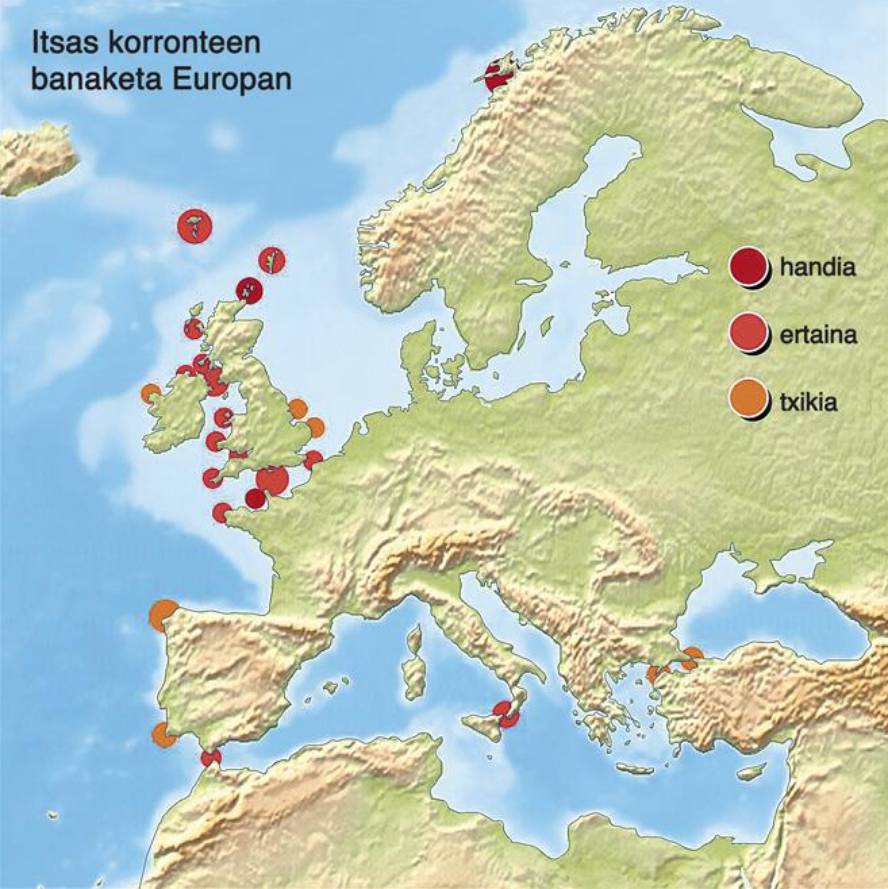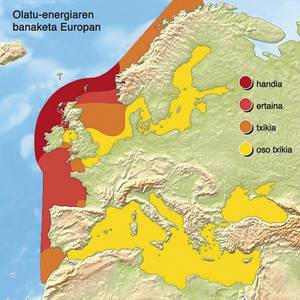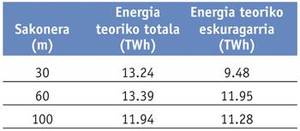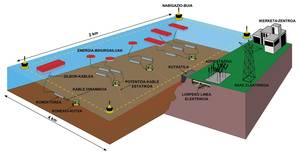Waves, a source of high potential energy
Martínez de Alegría Mancisidor, Iñigo
EHUko Elektronika Aplikatuko Ikerkuntza Taldeko (APERT) ikertzailea
In recent years, the words "energy crises" that have sparked debates have been frequently heard. Its origin lies in the unsustainable model of energy consumption policy carried by developed countries, a model that if not modified will cause serious consequences.
The American organization Energy Information Administration (EIA), in its report published in April 2011, made a forecast for energy consumption in 2035. This means that in 2035 current consumption will increase from 148 billion kW · h in 2008 to 226 billion kW · h in 2035. If these data are compared with fossil fuel reserves, it can be observed that these will not be enough to supply the energy demand, so the use of renewable sources will be essential.
Following the previous framework, a renewable resource that until now could be considered unknown gradually acquires relevance with the support of private and public entities. This resource is marine energy.
Marine energy
The potential energy of the seas is enormous. In addition, this energy can be obtained in several ways. The first method is the use of tides, based on the exploitation of potential energy released by the movement of rising and falling tides. For this technology to be viable it is necessary to resort to areas with tides above 6 m. The Basque Country has tides of 1.5 to 4.5 m (2.5 m on average), which would hinder the use of this technology.
The second way is to extract the useful energy from the kinetic energy of the marine currents, similar to how the wind leaves the wind. The most suitable areas for this are stretch marks and mouths, where current speeds are high (>1 m/s). In the Basque coasts the marine currents do not exceed the speed of 1 m/s, that is, normally 20 cm/s.
Another system is the use of the marine thermal gradient. Taking advantage of the water temperature difference can generate electricity. This requires a minimum thermal difference of 20ºC, so it is necessary to resort to tropical areas where the surface of the sea reaches an average temperature of 25-30ºC throughout the year and when diving 600-900 m the temperature difference mentioned is achieved. Therefore, the waters of the Cantabrian do not meet these requirements, as seen in the map of distribution of marine currents.
The fourth method is the profitation of the saline gradient. The exploitation is obtained from the saline difference between the seas and the rivers through a semi-permeable membrane located in the mouth of the rivers. But the Basque coast is also out of this technology.
The last way is to use the waves. Wave movement is received by a wave converter for later transformation into electricity using different pneumatic, hydraulic or mechanical techniques. The energy of the waves can be used from the coast to regions of depth above 50 m. We are working on the way for Euskal Herria to become a pioneer country of this technology, since, on the one hand, the Basque coast is an ideal place for the exploitation of energy from the waves and, on the other, the characteristics necessary to make the rest of the methods viable are not concentrated in the Basque areas.
Wave energy
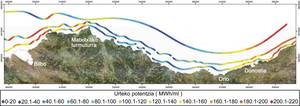
Wave energy is characterized by its energy density (2-3 kW/m 2) higher than other renewable sources (wind energy 0,4-0,6 kW/m 2; solar energy 0,1-0,2 kW/m 2), the existence of numerous operating sites, a resource close to consumers with a low environmental impact and a simpler prediction than wind energy. However, it must still compete with obstacles such as extreme weather conditions that occur at sea, the slow motion of waves (~0.1 Hz) to become a sufficient frequency to connect to an electric generator (50Hz) and the irregular directions, phases and amplitudes of waves, among others.
As mentioned above, to generate energy from waves it is necessary to use a device called a converter. There are many types of converters, but one of them has not yet stood out above others. All of them, in general, can be classified into three criteria:
- Depending on their location, three types are distinguished: onshore appliances; nearsohre appliances; and those located in deep waters off the coast ( offshore).
- Depending on its size and direction, three other types are those of small structure in relation to the size of the wave (point absorbers), long structure parallel to the direction of the wave (attenuators) and long structure perpendicular to the direction of the wave (terminators).
- Depending on the operating base, three other types: those based on the pressure difference exerted on a flow (OWC Oscillating Water Column, Archimedes effect); those containing floating bodies moved by waves; and those that extract energy (overflow systems or shock systems) from waves.
Wave energy on the Basque coast
On the Cantabrian coast there is a power between 34 and 49 kW/m, conditions in which the exploitation of this technology is viable.
The most appropriate regions for the installation of wave converters are the coast of Bilbao to Cape Matxitxako and the coast of Orio a Higer. There are other suitable areas but navigation and port accesses, anchorages or areas protected by environmental legislation have been discarded as exploitation areas.
Analyzing the potential and energy capacity of the Basque waves, it can be said that theoretically the energy of the waves can supply an electric consumption of between 37 and 50% of Basque households. On the other hand, although the higher energy flows are at great depth, it should be noted that these regions are not the best locations for the installation of converters, since their access and/or arrival is not easy, maintenance can be complex and are not well-known places. Consequently, it can be said that the areas with an average depth of 60 m and the areas close to the coast are the most suitable.
Wave energy projects
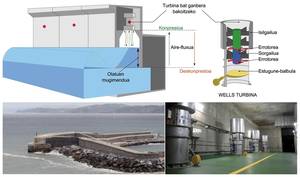
Euskal Herria has two important projects: OWC plant of Mutriku and Biscay Marine Energy Platform (BIMEP).
The Mutriku wave plant first connected to the network in July 2011. It is a pilot plant for the use of wave energy and the installed technology is OWC type. When the wave arrives, the water enters a chamber and compresses the air in it. The air flow then exits through the upper hole by activating a high-pressure turbine, which in turn rotates a generator, thus generating electrical energy. Moving away from the wave, it absorbs air through the hole, acting again on the turbine, generating energy as before.
The plant consists of 16 18.5 kW (Wells) air turbines, with a total capacity of 296 kW. According to the EVD, the estimated annual output is 600,000 kWh, enough energy to meet the electrical needs of 600 people. However, the main objective of the Mutriku plant is to test and publicize the viability of this technology.
The second project, called BIMEP, has another objective: to be an infrastructure prepared for the demonstration and research of offshore wave converters. This area will have an area of 4x2 km 2, located 1,700 m from the coast, in front of the pier of Armintza.
The sea area will be delimited by several buoys. In this way, four submarine cables of 5 MW of power will channel the dry energy generated by the wave converters, which will later be destined to the general distribution grid (132 kV/20 MW).
In addition, these cables will be equipped with fiber optics, which will allow researchers and technicians from the Armintza research and control center to obtain data on the performance and operation of wave converters essential for research. To date there is a single plant in the world, the EMEC (European Marine Energy Centre), in Scotland.
The infrastructure is expected to be completed between 2012 and 2013, and in the first four years of operation, 30 researchers are expected to work on research on different technologies around wave energy.
Conclusions
Among the renewable sources that make up marine energy, wave energy is the one that receives the most attention from public and private entities. This is due to its high energy density, its large number of operating sites and its proximity to the consumer. The coast of the Basque Country is an ideal place for the production of this technology, and the benefits that can be reported cannot be ignored. In addition, thanks to the projects being carried out, the road has begun to turn Euskal Herria into a reference of wave energy.



